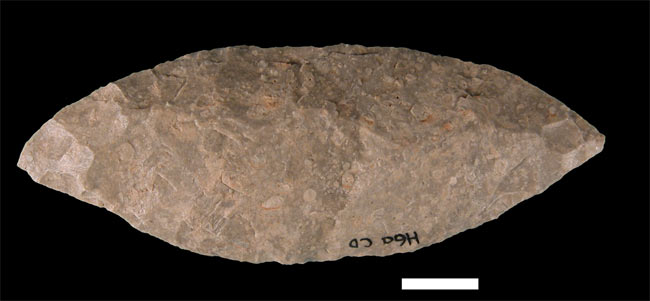Early Humans' Weapon-Making Skills Sharper Than Expected

A delicate, sophisticated way to craft sharp weapons from stone apparently was developed by humans more than 50,000 years sooner than had been thought.
The finding could shed light on what knowledge people were armed with when they started migrating out of Africa.
The artful technique is known as pressure flaking. Early weapons' makers typically would use hard blows from a stone hammer to give another stone a rough blade-like shape, then would use wood or bone implements to carve out relatively small flakes, refining the blade's edge and tip.
When done right, pressure flaking can provide a high degree of control over the sharpness, thickness and overall shape of sharp tools such as spearheads and stone knives, said researcher Paola Villa, an archaeologist at the University of Colorado Museum of Natural History.
Pressure flaking has long been considered a fairly recent innovation, with the earliest examples seen roughly 20,000 years ago in the Solutrean culture in France and Spain. Now, however, researchers say Blombos Cave in South Africa yielded what seem to be 75,000-year-old spearheads made by anatomically modern humans using pressure flaking.
"We did not expect to find evidence of this very skillful method for shaping and retouching stone artifacts at such an early time," Villa told LiveScience.
In addition to these sharp points, the site yielded other evidence of modern human behavior, such as artwork in the form of shell beads. These are all linked to the so-called Still Bay industry, a Middle Stone Age tool-manufacturing style that was adopted roughly 76,000 years ago and may have lasted about 4,000 years.
Sign up for the Live Science daily newsletter now
Get the world’s most fascinating discoveries delivered straight to your inbox.
"This finding is important because it shows that modern humans in South Africa had a sophisticated repertoire of toolmaking techniques at a very early time," Villa said. "This innovation is a clear example of a tendency to develop new functional ideas and devices. It adds to the complex of novel behaviors already documented at the site, and shows that the Still Bay was a time when novel ideas and techniques were rapidly developed."
The stone points were made of silcrete, or quartz grains cemented by silica, which needs to be heat-treated before pressure flaking. To confirm that was how the newfound artifacts were made, Villa and her colleagues analyzed microscopic details of 159 silcrete points and fragments, 179 other retouched pieces and more than 700 flakes in Blombos Cave from the Still Bay industry.
The removal of flakes from unheated silcrete produces scar surfaces with a rough, dull texture. However, the surfaces of silcrete that was treated with heat have a smooth, glossy appearance. The researchers concluded that at least half of the ancient, finished points at Blombos Cave involved pressure flaking with heat-treated silcrete.
The scientists also experimentally crafted stone points using both heated and non-heated silcrete chunks collected from outcrops roughly 20 miles (32 km) from Blombos Cave. They found that unheated chunks could not be pressure flaked, while blocks of heated silcrete yielded points very much like the ones discovered.
Villa and her colleagues speculate that pressure flaking was invented in Africa and proved crucial to survival when Homo sapiens migrated from the continent about 60,000 years ago, leading to the technique's widespread adoption in Europe, Australia, North America and later Africa.
"More technological studies like ours, based on experimental replication, microscopic studies and detailed analysis of stone artifacts, supported by statistics, should be applied to other archaeological assemblages in South Africa and in other regions," Villa said. "It is important to understand if there are precursors or antecedents in older industries. It is also important to understand if the method was used in the following period — that is, on the backed blades of the Howiesons Poort, a South African culture dating to 65,000 to 60,000 years ago, thus establishing continuity and cultural transmission between social groups in South Africa."
The scientists detail their findings in tomorrow's issue (Oct. 29) of the journal Science.
- Top 10 Mysteries of the First Humans
- Top 10 Things that Make Humans Special
- 10 Animals That Use Tools

Why is yawning contagious?
Scientific consensus shows race is a human invention, not biological reality









